Risk
Global Equities
Two of the biggest investment stories of the last year might sound familiar: Companies leading the artificial intelligence (AI) charge soared while the U.S. remained the global economy’s workhorse.
But a new year always brings change and 2025 is likely to be no different, in part because investors will be watching closely as the second Trump administration works on policy changes. Combine that with a U.S. economy that is dynamic yet hard to predict, and it creates a perfect environment for investment professionals to flex their analytical muscles.
We invited Capital Group equity portfolio managers Brant Thompson and Cheryl Frank, investment director Jayme Colosimo and equity analyst Caroline Janin to discuss the economic outlook and where they see opportunities.
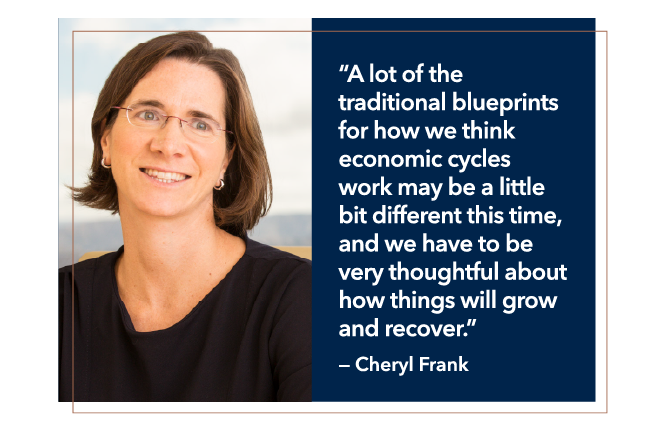
The U.S. economy continues to defy naysayers, growing 2.8% last year and projected by the International Monetary Fund (IMF) to grow 2.7% this year. What’s powering this resilience and where do we go from here?
Jayme Colosimo: I always start with a reminder that not everyone at Capital Group shares the same view, and we think that’s a strength. Still, many of our economists have a positive outlook. The U.S. is growing far faster than other developed markets, and much of that comes from the strength of its productivity.
We’ve been using the metaphor of the “Benjamin Button” economy, named after the character who ages in reverse. The U.S. economy has been showing a lot of late-cycle indicators, but many of us see the potential that it could be moving back toward mid-cycle, when businesses are expanding and growth is robust. Many of the folks on the team expect GDP this year to be at the higher end of projections, some even leaning into 3%.
This characterization results from three core things: the strong productivity I mentioned; a resilient even-if-slowing labor market; and tailwinds from continued capital expenditure and public investment, which will likely be supported this year with looser fiscal policy. That all implies more growth, but it also implies more inflation and higher interest rates — at least, rates staying higher for longer.
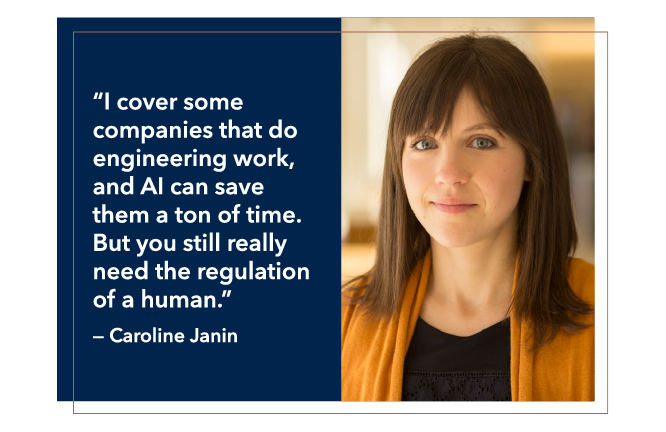
Brant Thompson: From a macro standpoint, one of the things I try to focus on is the health of real consumer income. Over the last two years, falling inflation has been positive for real consumer income. The consumer is 70% of the U.S. economy, so it’s a material force. Yet we’ve also seen a split in the economy — for example, some industrial areas have had really good growth while others have had contraction.
Moving into this year, there are some real debates around how robust real consumer income is going to be. A lot of that will depend on how inflation trends and how tariffs impact prices. Going forward, real consumer income looks healthy but the tailwinds are not as strong as they were.
Cheryl Frank: One of my big views is that COVID really threw off some of the traditional economic cycles of booms and busts. Tech and defensive sectors boomed at the same time, which usually doesn’t happen. A lot of the traditional blueprints for how we think economic cycles work may be a little bit different this time, and we have to be very thoughtful about how things will grow and recover.
The pandemic also had a big impact on the labor market. There’s a real mismatch of people and jobs right now that’s creating higher wage inflation than you might normally expect at this level of unemployment. There are still shortages of skilled workers.
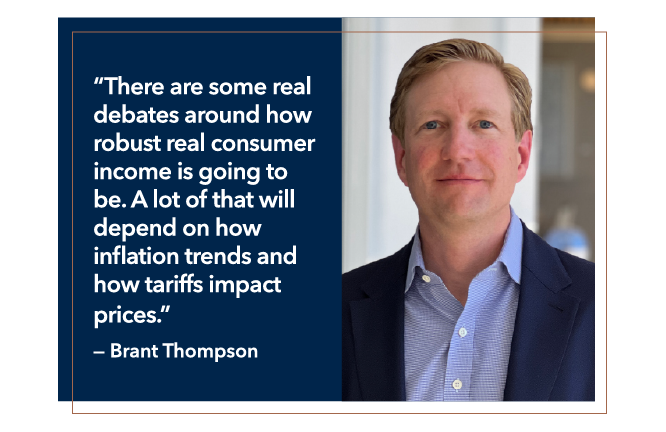
You recently discussed that labor mismatch in a research note. Could you expand on it a little?
Frank: It’s a big question for the next decade, especially in light of how AI is impacting labor. I think we’re going to have a lot of white-collar work that can be replaced by AI and a lot of blue-collar work that we don’t have workers for. As we’re trying to build data centers, we’re going to need people who have expertise in welding, HVAC, plumbing and other areas. Labor became disjointed in the pandemic. It’s still creating shortages in the aerospace market. In some of my recent visits, companies were still talking about supply chain issues, mainly caused by openings they haven’t been able to fully fill after skilled workers left during COVID.
Speaking of aerospace — Caroline, aerospace and defense are a major part of your coverage area. How does the economy flow through to them?
Caroline Janin: Aerospace is exposed to the economy to the extent that it affects demand for flights. But most of the demand in the next 10 or 20 years isn’t coming from developed markets — it’s coming from people in places like India and China, where GDP is getting to levels that support more air travel. The industry is less economically sensitive than people believe. In any case, the big constraint really is supply, not demand — there’s a significant backlog for new plane production.
For defense companies, a big question is government budgets. Ultimately, their customers are governments. In the U.S., that’s a question about President Trump. He’s sort of an isolationist, but we can look at his first four years as a track record. Each year he was in office before, his budget requests for defense were larger. I don’t think he’ll cut defense budgets now. Congress would likely follow; it’s very unpopular to cut defense budgets because of the jobs the industry provides. Production of the F-35, for example, involves 48 states.
In Europe, there’s a lot of discussion. Despite all the political events in France recently, the consensus there seems to be that they’re going to figure out how to keep defense spending at a higher level. There’s a similar situation in Germany and the U.K. The U.K.’s new government has already committed to keep defense spending at 2.5% of the budget.
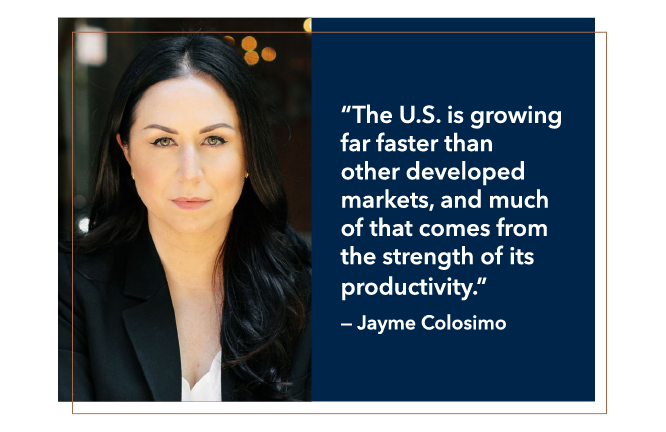
The outlook for the world beyond the U.S. has been less rosy, and that’s been reflected in the major indices. How are you approaching investments outside the U.S.?
Frank: A couple of factors are making certain non-U.S. markets somewhat challenging. Trump’s threat to implement tariffs is one. I’m not sure the tariffs would be permanent — I think they’re meant to drive better trade deals — but they would result in a rearrangement of the import-export balance. They would certainly be an incremental headwind for a lot of regions, and I don’t think Europe will escape them.
Another thing to keep in mind is that all the investment in AI is part of what’s buoying the U.S. economy. It’s just a bigger part of the business mix, so when technology does well, that affects the U.S. more. But technology companies elsewhere are doing well, too. I would highlight examples like Taiwan Semiconductor Manufacturing Co. and SAP in Europe. But overall, if a region’s not as exposed to the areas that are really growing, like AI or the internet are now, that will make overall growth a challenge.
We’ve talked a little about Trump’s return to the White House already — how else could the new administration impact investors?
Frank: One of the challenges right now is to understand Trump’s motivations. He sees defense and deterrence as very important globally; I think he wants to settle some global conflicts so he can focus on China. Deregulation is going to be a big part of his agenda, and that will affect many industries, from oil to banks.
But while he favors executive orders over legislation, he will need Congress for many things, and that could be an issue for him. A one-party sweep doesn’t always equate to power. There are always one or two people who will hold up the process, so I wouldn’t expect that we’re going to see a big Republican legislative agenda. I just don’t think they have all the votes and the party unity necessary.
Colosimo: Uncertainty is something of the word of the day. We’re waiting to see how certain policies will play out. However, one of the things we really reinforce is that we don’t position portfolios for binary outcomes. We consider where we might be headed, really taking a range of scenarios into account.
Thompson: There are trends at the company and industry levels that are outside politics, too. I don’t think that trends related to AI, obesity drugs, or the shift to card payments from cash will change. The government is involved in all these things, but it won’t be the most important force.
Obviously, one of the biggest market trends today is AI. We’ve touched on the technology a little, but do you think it’s going to be as impactful as markets think? How are you seeing it used now?
Janin: I cover some companies that do engineering work, and AI can save them a ton of time. But you still really need the regulation of a human. Even for raw calculations — one company I cover, which calculates valuations for funds and private equity firms, their margins are getting better because of AI, but they’re careful to make sure they’re still providing services that need humans.
Thompson: Over time, we should expect AI to shift competitive barriers, as well as the barriers to adopting various facets of technology. Companies are already starting to offer more examples of how AI is improving productivity or changing the economics of parts of their business.
Take, for example, companies that have customer service call centers. This is high-cost customer support. The ability to automate the call agent could dramatically reduce the costs of that customer calling. It may also enable better service and the ability to learn more about your customer needs. That input could influence how you build your next product.
Those kinds of second- and third-order impacts are rarely part of the original vision for a new technology. Yet that’s where you often see the biggest value creation. With the internet, companies like Cisco helped build the networks, but the value didn’t accrue to them ultimately. It went to the Googles and Facebooks of the world.
Colosimo: That process is characteristic of many technological revolutions. New technologies are very rarely matched with their most promising application
from the start. It’s only after industries uncover new applications and the technology evolves — even the technology for the internet was around decades before we had the World Wide Web.
Of course, I don’t want to draw too close of an analogy. There are some differences in this technological cycle. AI has been enabled by existing technologies, like the cloud and other connectivity advances. It’s been widely adopted across sectors and industries, and across a diversity of applications. And AI is self-improving, letting it accelerate its adoption in ways we haven’t seen historically.
Thompson: One of the exciting applications is autonomous driving technology. It’s no longer a question of “will it work?” It’s rolled out in San Francisco, L.A. and a few other cities. It’s coming to many more. Lots of people will soon experience this for the first time, and that will give them a sense of what AI technology is capable of.
Related Insights
Related Insights
-
What L.A. wildfire victims need to know about taxes and other financial matters
-
Risk
Preparing for the unexpected: How to financially plan for an emergency or disaster -
Financial Planning
Tax changes are almost certain. Are you prepared?

 Cheryl Frank
Cheryl Frank
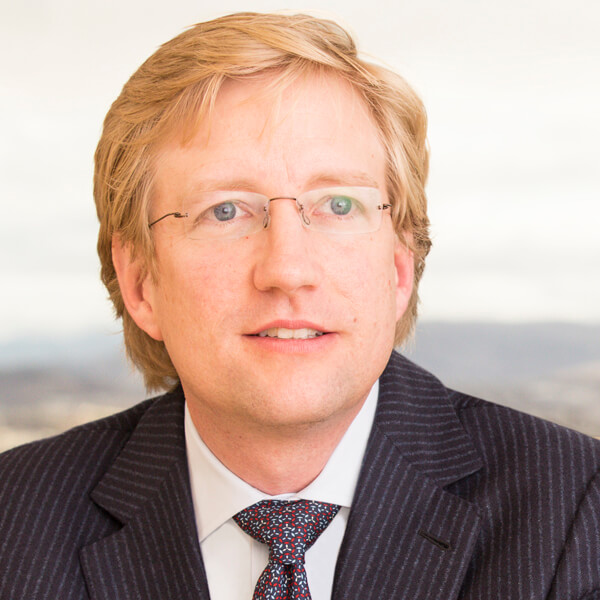 Brant Thompson
Brant Thompson
 Jayme Colosimo
Jayme Colosimo
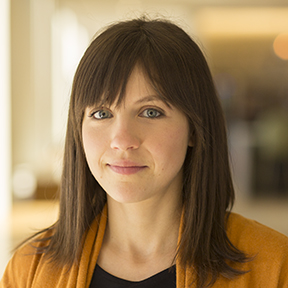 Caroline Janin
Caroline Janin